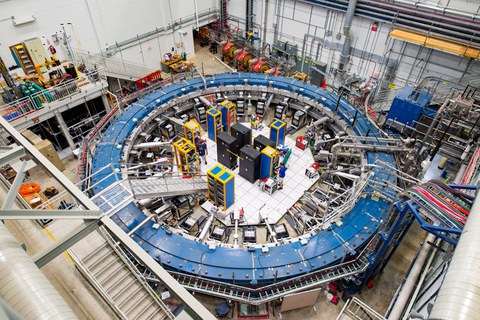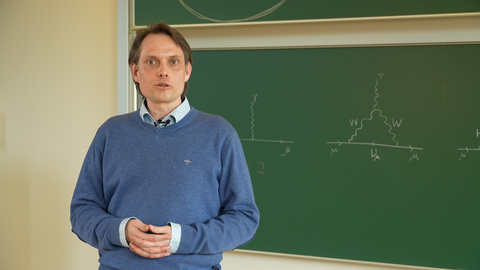Apr 07, 2021
Solid evidence for new physics

The Muon g-2 ring sits in its detector hall amidst electronics racks, the muon beamline, and other equipment. This impressive experiment operates at negative 450 degrees Fahrenheit and studies the precession (or wobble) of muons as they travel through the magnetic field.
Fermilab (USA) today released the first data from the muon g-2 experiment, confirming the results from the 2001 experiment of the same name at Brookhaven National Laboratory. A breakthrough in the physics world, since the values deviate from the Standard Model of particle physics, strengthening the evidence that physics beyond the Standard Model exists. TUD physicist Dominik Stöckinger has been involved in the Fermilab investigations for years. Together with his wife, Dr. Hyejung Stöckinger-Kim, he devotes particular attention to the theory of the subject at the Institute for Nuclear and Particle Physics. They believe that previously unknown elementary particles or interactions could be the cause of the deviation from the g-factor of the muon calculated in the Standard Model.

Prof. Dominik Stöckinger
"A fantastic day and a fantastic result!" Prof. Dominik Stöckinger from the Institute of Nuclear and Particle Physics at TU Dresden can hardly put his joy into words. In an online seminar today, April 7, 2021, at 10 am US CT time, the results of the first measurement of the muon g-2 experiment at Fermilab were presented. An event that physicists around the world have been waiting for for almost 20 years.
Back in 2001, the first experimental measurement of the g-2 value of muons was carried out at Brookhaven National Laboratory. Muons are similar to electrons in many of their properties, they are just much heavier. Muons occur naturally when cosmic rays strike Earth’s atmosphere, and particle accelerators can produce them in large numbers. All interactions and elementary particles contribute with their respective properties to the g-factor of the muon. The Standard Model predicts this so-called anomalous magnetic moment very precisely. However, if additional forces or particles exist that are not accounted for by the Standard Model, this would change the g-factor of the muons. The first measurement in 2001 showed a significant deviation of the experimental value from the theoretically determined value of the Standard Model. Unfortunately, the experiment was not sensitive enough to exclude a random fluctuation of the measured value as a cause.
The measurements performed at Fermilab in 2018 are highly precise and therefore more reliable than the previous experiment. Surprisingly, the results presented today confirm the values from back then and thus open up a completely new view of the subatomic world.
The accepted theoretical values for the muon are:
g-factor: 2.00233183620(86)
anomalous magnetic moment: 0.00116591810(43)
The new experimental world-average results announced by the Muon g-2 collaboration today are:
g-factor: 2.00233184122(82)
anomalous magnetic moment: 0.00116592061(41)
Even if the values differ only in the eighth decimal place, this deviation strengthens the indication that the standard model of elementary particle physics is inadequate.11For Prof. Dominik Stöckinger, who has been involved in the Fermilab experiment from the very first moment, the evidence for hitherto unknown elementary particles is growing stronger. "As theoretical physicists, we have worked for many years to develop theoretical predictions that could then be compared with this experiment. In our work, we have already seen that some, but by no means all, ideas for such new physics can explain this divergence. We will now combine the result published today with other elementary particle experiments and analyze exactly what kinds of new particles, for example dark matter particles, additional Higgs particles, or perhaps even more exotic particles, could best explain the observations in order to make progress in understanding fundamental physics."
The public presentation of the Fermilab results will take place during a press conference on April 7, 2021, 12:00 - 12:45 pm US CT.
Press conference link:
https://fnal.zoom.us/j/95785531415?pwd=V1N4bjlNMEJTRlVvYzZMU2NJRzVXdz09
Website of the muon g-2 experiment at Fermilab: https://muon-g-2.fnal.gov/
Interview mit Dominik Stöckinger und Hyejung Stöckinger-Kim zum Myon g-2-Experiment © TU Dresden
Media inquiries:
Prof. Dominik Stöckinger
Institute of Nuclear and Particle Physics
Fußnoten
-
The combined results from Fermilab and Brookhaven show a difference with theory at a significance of 4.2 sigma, a little shy of the 5 sigma (or standard deviations) that scientists require to claim a discovery but still compelling evidence of new physics. The chance that the results are a statistical fluctuation is about 1 in 40,000.
